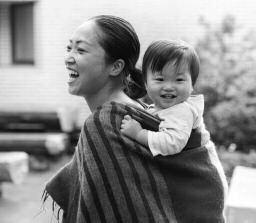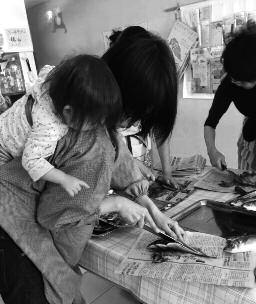AIMS Journal, 2016, Vol 28 No 3
Akiko Kamura looks at the enormous benefits of Japanese baby carrying
Every aspect of our lives has become so convenient, yet so commercial, and it's getting harder to maintain a healthy motherhood.
Have you ever tried knitting while carrying your baby on your back? Some people say, 'Yes, it works better when you stand up and rock, the nice thing is you actually give your baby the most heavenly moment. It must be a completely different feeling from being left alone in a cradle!' The experts warn that it's essential to learn how to carry a baby correctly on your back. Carrying your baby in a high position (see photo opposite) is key; experts report that it doesn't damage the spine, as long as they carry the baby at the height that allows them almost to face baby directly. Most babies are very happy in that high position because they can watch what their caregivers are doing over their shoulders.1
This form of Japanese baby carrying is called onbu and it's different from the Western style derived from Africa. The baby is not carried on one's hip – instead it is carried on the upper part of one's back. It is said that when the lower body is evenly grounded by the weight of a baby, a mother can stand in a healthier way; she improves her sense of core and her spine is nicely aligned. In short, when we focus on our lower part it becomes easier to release ourselves from our head and be more intuitive.1
It takes time for you to feel comfortable with your baby on your back. It can be strange at first to get used to knowing how your baby is without watching: it's actually nothing special. Just like you used to try to sense where your friend was hiding herself when you played hide and seek, we can extend our awareness around our surroundings wider and deeper than we realize.
It's important that we don't interfere too much and we respect our babies' own time and space, babies can look up at the blue sky, or choose to learn by carefully watching you cook and knit. Children acquire social norms by watching what the caregiver does over their shoulders. They don't have to check the caregiver's expression or to ask permission. They don't need to know what the caregiver likes about the world or doesn't, which risks giving babies too much bias in exploring things. Onbu is a gentle, more open approach, which enables mothers and babies to become free.

In developed countries, our kids tend to be considered small adults and brought up with strict rules and discipline and mothers may feel constantly distracted by their children. Their mind is always preoccupied by worrying about their babies who are a certain distance away in a cradle, on a bed, on a sofa, on the floor, in a push buggy or in someone else's hands (like a baby sitter). However, if a mother can trust and feel comfortable that her baby is safe on her back, she is less likely to bemstressed, and caregivers actually gain their own personal space in the front part of the body. Yes, keeping a baby on our back stretches our ability to trust, but it's beneficial for both a baby and a mother, as I will explain later. The baby feels protected while the mother creates her own, non-disturbed zone. I don't mean to suggest a baby is disturbing, but we all need our personal space sometimes, right? Can you do your knitting while you carry your baby on your front?
Makiko Saito2 states that 'once we re-integrate the ability to sense things by focusing on our back, “a spinal sensor”, we become so grounded that we are no longer bothered by subtle things, like comparing your child-rearing with that of other people. I believe that keeping an energy balance between the front and the back parts of the body is the best condition for motherhood. Within a sustainable balance between front and back you can make the best decisions for your children. A mother's front tends to be more occupied for longer as baby needs mother's milk anyway.' That is the biggest reason I wrote this article. I want to invite people to bring more awareness to their backs, for better energy use. I believe keeping an eye on balance is important, if one part of your body is always busy then you can allow that part to rest while using the other part.
I am not saying everyone should use the piggy-back technique. This is just an invitation to create more space, more time, and more ways of communicating between babies and their caregivers. It may be a new approach for you but why not give it a try and see how your back can be warmed by your baby while the energy level at the front will be calmed. I know from my personal experience that this is indeed true. As you keep your baby on your back everything becomes much easier, soon you instantly know if your baby is about to sleep or is getting a temperature; by sniffing I could easily find out if my daughter was wanting to do a poo soon and by sensing the movement I got that she needed a wee. So, when you read your baby's condition with your back's sensations, you may find you are trusting and relaxed, able to concentrate on some complicated handwork, perhaps filleting fish with a sharp knife. Another great thing about it is that your baby can learn from watching what you do and even learn how to cut fish properly (see photo aboveof a baby watching carefully how to cut fish). There is no doubt in my mind that a mother's back is one of the best spaces for a child to learn new things about our world.

I once saw my mother-in-law teaching my daughter over her shoulder. One summer day, my mother-in-law was carrying her granddaughter on her back and my baby was reaching out her arm to a green tomato. My mother-inlaw gently, but very quickly, caught my daughter's small hand and invited her little fingers to pick a maturely red tomato. I was very inspired by watching the scene. It was done in the twinkling of an eye! And she managed to teach one important rule by using the experience of an actual movement. She was not facing my daughter but she softly guided her small hand to pick the right one instantly. My mother-in-law said to me later 'She still doesn't speak yet so we will have to be careful. It's all about timing. Introduce each new thing at the right time for your baby. How you teach them for the very first time is crucial. Remind yourself not to think too much in your head.' I think what my mother-in-law was trying to convey was about distance (physical, symbolic or emotional). If a caregiver and a baby are inseparably attached, there is minimum distance and maximum time. There is no need for words to explain the reasons when you can easily direct the situation by your actual movement. I wonder when we lost the way of intuitive childrearing. Masayo Sonoda points out that Japan imported many child-rearing methods and 'commodities' from North America. There three major elements that had a huge impact: The first one was a child-rearing practice to discourage babies from wanting to be held in order to be happy. Before the end of WW2, parents never ignored crying babies and always slept with their babies in the same room. The second one was the aggressive introduction of artificial milk. The third one was childbearing at institutions, a radical shift from home birth to hospital birth. These three major elements drastically changed the environmentmof childbearing and childrearing. Onbu culture, however, in recent years has been being reclaimed and the first onbu conference was held in Tokyo in 2014 and 2015. So, onbu re-emerges as a 'new' traditional mother-baby bonding style.
Lastly, Makiko Saito, one of the most influential birth educators and an Onbu expert, mentions the benefits of onbu. She has seen, over the last 20 years, that babies who have been carried are less likely to get hypothermia; have healthy abdominal conditions and show an incredible ability to hold onto their whole body sensations. Because a baby itself has to cooperate with caregivers to be carried the baby naturally develops a sense of balancing and holding which creates a strong core and a sense ofm healthy emotion, such as compassion and cooperation to work for one purpose.
Compared with 10 years ago in the UK, I joyously noticed, on buses, trains and in the park, many young parents had already started to keep their babies on their front (with slings and wraps). Babies are super happy being attached in any mode you prefer.
There will be so many reasons for us not to carry our babies too. Some are because of the stigma attached to the mothers having their babies on their back who might be seen as coming from a poor family background, immigrants or someone coming from 'outside' of the society. It's sad because having a baby on us has immense possibilities. It doesn't cost us anything and we can unconsciously bring our awareness to the other's feeling and other's sensation. We call it 'compassion' and it's a basic need of our human society. We express the attitude of knowing the others as 'reading the air'. Knowing others by a subtle movement or tone of the voice or verbally unexplainable sensation requires experience. Mutual compassion is so needed in our society today. It sometimes seems as if we have completely forgotten to take care of others; 'feeling' a baby is taking care of theothers and 'being' with a baby is an invitation to integrate ourselves into peaceful transition, 'My spine has become asensor!' exclaimed those mums who enjoy their 'onbu' lifestyle. They wink and add, 'you can do almost everything at your own pace while taking care of your baby. Isn't it great?' If we can cultivate our inner core to 'sense' ourmbabies we may never again use the excuse that we have no time for knitting!
References
Sonoda M (2016) Recent Trend of Outing with Toddlers in Japan. Translated summary information at babywearing.co.jp
Onbu pro (2016) www.uminoie.org/ – translated information at www.babywearing.jp/blog/category/english-article
The AIMS Journal spearheads discussions about change and development in the maternity services..
AIMS Journal articles on the website go back to 1960, offering an important historical record of maternity issues over the past 60 years. Please check the date of the article because the situation that it discusses may have changed since it was published. We are also very aware that the language used in many articles may not be the language that AIMS would use today.
To contact the editors, please email: journal@aims.org.uk
We make the AIMS Journal freely available so that as many people as possible can benefit from the articles. If you found this article interesting please consider supporting us by becoming an AIMS member or making a donation. We are a small charity that accepts no commercial sponsorship, in order to preserve our reputation for providing impartial, evidence-based information.
AIMS supports all maternity service users to navigate the system as it exists, and campaigns for a system which truly meets the needs of all.